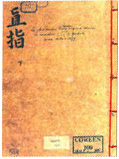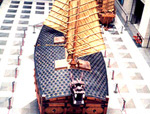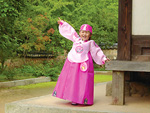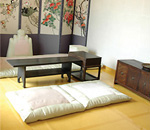 Dolmens, relics of the prehistoric megalithic culture, are being unearthed worldwide. Among the well-known megalithic relics are Stone Henge in England and Moai stone statues on Chile’s Easter Island. Although dolmens are scattered around the world, few places have the large numbers clustered in relatively small areas that Korea does. Furthermore, according to some scholars’ research result, there are 70% of dolmens of the world are situated in Korean peninsula. Relics found in these regions are invaluable for studies on the culture and society of prehistoric Korea. In particular, the Gochang, Hwasun and Ganghwa dolmen sites highly praised for their archaeological worth were added to the United Nations Educational Scientific and Cultural Organization(UNESCO) World Heritage list in 2000.
Dolmens, relics of the prehistoric megalithic culture, are being unearthed worldwide. Among the well-known megalithic relics are Stone Henge in England and Moai stone statues on Chile’s Easter Island. Although dolmens are scattered around the world, few places have the large numbers clustered in relatively small areas that Korea does. Furthermore, according to some scholars’ research result, there are 70% of dolmens of the world are situated in Korean peninsula. Relics found in these regions are invaluable for studies on the culture and society of prehistoric Korea. In particular, the Gochang, Hwasun and Ganghwa dolmen sites highly praised for their archaeological worth were added to the United Nations Educational Scientific and Cultural Organization(UNESCO) World Heritage list in 2000.
 Baegun hwasang chorok buljo jikjisimcheyojeol (Vol.II) the second volume of“Anthology of Great Buddhist Priests Zen Teachings” Jikjisimcheyojeol, often abbreviated as Jikji, is the world’s oldest movable metal type printed book. It was printed 77 years earlier than Germany’s Gutenberg Bible which was published in 1455. Jikji is a collection of Buddhist treatises and teachings compiled by the ancient monk Baegun at Heungdeok-sa Temple in Cheongju, North Chungcheong Province, in July 1377. Originally two volumes, only its latter volume is still extant. It is in the possession of the National Library of France in Paris. Jikji was inscribed in the Memory of the World Register inSeptember 2001, in an effort to preserve its documentary heritage as a common heritage of humanity
Baegun hwasang chorok buljo jikjisimcheyojeol (Vol.II) the second volume of“Anthology of Great Buddhist Priests Zen Teachings” Jikjisimcheyojeol, often abbreviated as Jikji, is the world’s oldest movable metal type printed book. It was printed 77 years earlier than Germany’s Gutenberg Bible which was published in 1455. Jikji is a collection of Buddhist treatises and teachings compiled by the ancient monk Baegun at Heungdeok-sa Temple in Cheongju, North Chungcheong Province, in July 1377. Originally two volumes, only its latter volume is still extant. It is in the possession of the National Library of France in Paris. Jikji was inscribed in the Memory of the World Register inSeptember 2001, in an effort to preserve its documentary heritage as a common heritage of humanity
 Geobukseon is a battleship engineered by a scientist at the order of Admiral Yi Sun-sin of the Joseon Dynasty, Korea’s most-revered hero. “Turtle” is “geobuk” in Korean, and the similarity in appearance between these two hard-shelled creatures explains the name. The upper deck was covered with a rounded wooden roof that itself was studded with pointed iron spikes to repel enemies trying to board. During the war, Admiral Yi Sun-sin won every one of at least 23 naval battles he fought, boasting an unprecedented record of victories. Admiral Yi has often been compared with Lord Nelson, the British hero who triumphed over the French-Spanish fleet at the Battle of Trafalgar. Both admirals fought for the destiny of their countries and saved their countrymen from foreign invasion by securing key naval victories. Recognized as a breakthrough in military technology, Geobukseon replicas are on exhibit in a number of national museums, including the War Memorial of Korea, the War Memorial Museum in the U.S., the National Maritime Museum in England and historical museums in China, Germany and other countries.
Geobukseon is a battleship engineered by a scientist at the order of Admiral Yi Sun-sin of the Joseon Dynasty, Korea’s most-revered hero. “Turtle” is “geobuk” in Korean, and the similarity in appearance between these two hard-shelled creatures explains the name. The upper deck was covered with a rounded wooden roof that itself was studded with pointed iron spikes to repel enemies trying to board. During the war, Admiral Yi Sun-sin won every one of at least 23 naval battles he fought, boasting an unprecedented record of victories. Admiral Yi has often been compared with Lord Nelson, the British hero who triumphed over the French-Spanish fleet at the Battle of Trafalgar. Both admirals fought for the destiny of their countries and saved their countrymen from foreign invasion by securing key naval victories. Recognized as a breakthrough in military technology, Geobukseon replicas are on exhibit in a number of national museums, including the War Memorial of Korea, the War Memorial Museum in the U.S., the National Maritime Museum in England and historical museums in China, Germany and other countries.
 King Sejong decreed the creation of the Korean alphabet Hangeul to ease the life of commoners in 15th century Joseon. In 1446, the first Korean alphabet system consisting of 14 consonants and 10 vowels was completed and proclaimed “Hunminjeongeum,” literally “the correct sounds for the instruction of the people.” Along with the creation of Korean letters, King Sejong published a manual explaining their derivation and how to use them properly. It has become a UNESCO World Documentary Heritage, and the UNESCO King Sejong Literacy Prize established in 1989 annually pays tribute to those who have made outstanding achievements in promoting literacy.
King Sejong decreed the creation of the Korean alphabet Hangeul to ease the life of commoners in 15th century Joseon. In 1446, the first Korean alphabet system consisting of 14 consonants and 10 vowels was completed and proclaimed “Hunminjeongeum,” literally “the correct sounds for the instruction of the people.” Along with the creation of Korean letters, King Sejong published a manual explaining their derivation and how to use them properly. It has become a UNESCO World Documentary Heritage, and the UNESCO King Sejong Literacy Prize established in 1989 annually pays tribute to those who have made outstanding achievements in promoting literacy.
 As the Scottish have kilts, Peruvians ponchos and Indians saris, Koreans have Hanbok, their traditional garment. Originating in the ancient Korean kingdoms, its design and variety has been fairly steady from medieval to modern times, differing only based on the season or gender. While Koreans today generally only wear authentic Hanbok on special occasions such as weddings and traditional holidays, modern variations like Saenghwal Hanbok that have been tailored to fit modern lifestyles are sometimes seen in everyday life. Korean designers continue to introduce Hanbok-themed clothes to the Western world via worldfamous fashion events such as France’s Pret-a-Porte
As the Scottish have kilts, Peruvians ponchos and Indians saris, Koreans have Hanbok, their traditional garment. Originating in the ancient Korean kingdoms, its design and variety has been fairly steady from medieval to modern times, differing only based on the season or gender. While Koreans today generally only wear authentic Hanbok on special occasions such as weddings and traditional holidays, modern variations like Saenghwal Hanbok that have been tailored to fit modern lifestyles are sometimes seen in everyday life. Korean designers continue to introduce Hanbok-themed clothes to the Western world via worldfamous fashion events such as France’s Pret-a-Porte
 Ondol is a uniquely Korean heating system that can be traced back to the ancient kingdom of Goguryeo. Unlike Western heaters that generally warm the air, Ondol heats the floor of a room. Invented by ancient Koreans, the original system worked by heating a large stone under a living space: Smoke from a fire just outside the dwelling was forced under the stone and exited on the other side. The system survives today in modern houses and apartments where water heated in gas or electric boilers is circulated through pipes encased in cement floors.
Ondol is a uniquely Korean heating system that can be traced back to the ancient kingdom of Goguryeo. Unlike Western heaters that generally warm the air, Ondol heats the floor of a room. Invented by ancient Koreans, the original system worked by heating a large stone under a living space: Smoke from a fire just outside the dwelling was forced under the stone and exited on the other side. The system survives today in modern houses and apartments where water heated in gas or electric boilers is circulated through pipes encased in cement floors.
 Among the various kinds of Insam grown around the world, the Korean variety, Goryeo Insam named after the ancient Korean kingdom is unsurpassed in aroma and flavor. Goryeo Insam grows best in the soil and climate found on the peninsula. The Korean people have traditionally treated Insam as medicine as well as a health food supplement. In fact, a study on Insam’s efficacy conducted by the Canadian Medical Association Journal found that subjects taking ginseng extract suffered fewer cold symptoms. Of all the varieties of Insam classified GRAS (generally recognized as safe) by the U.S. Food and Drug Administration, only Goryeo has been listed in the European Union’s pharmacopoeia.
Among the various kinds of Insam grown around the world, the Korean variety, Goryeo Insam named after the ancient Korean kingdom is unsurpassed in aroma and flavor. Goryeo Insam grows best in the soil and climate found on the peninsula. The Korean people have traditionally treated Insam as medicine as well as a health food supplement. In fact, a study on Insam’s efficacy conducted by the Canadian Medical Association Journal found that subjects taking ginseng extract suffered fewer cold symptoms. Of all the varieties of Insam classified GRAS (generally recognized as safe) by the U.S. Food and Drug Administration, only Goryeo has been listed in the European Union’s pharmacopoeia.
 Just as Germans relish sausages, Indians curry, Italians pizza, the Korean people love Kimchi. A staple that accompanies Koreans on journeys across the world, Kimchi is a pungent, fermented dish made from a range of vegetables cabbage, cucumbers, seasoned with salt, garlic, green onions, ginger, red chili pepper and other herbs and spices. It may be savored as it is or used as an ingredient in a wide variety of dishes. On July 5, 2001, Kimchi was approved as an international standard by the Codex Alimentarius Commission (CAC), an international organization in charge of setting up internationally available food standards with the goal of promoting the trade of food items. Furthermore, an American monthly magazine Health, selected Kimchi as one of the world’s five healthiest foods in its March online edition. According to the magazine, Kimchi is rich in Vitamins A, B and C and bacteria lactobacilli, healthful bacteria that aid digestion.
Just as Germans relish sausages, Indians curry, Italians pizza, the Korean people love Kimchi. A staple that accompanies Koreans on journeys across the world, Kimchi is a pungent, fermented dish made from a range of vegetables cabbage, cucumbers, seasoned with salt, garlic, green onions, ginger, red chili pepper and other herbs and spices. It may be savored as it is or used as an ingredient in a wide variety of dishes. On July 5, 2001, Kimchi was approved as an international standard by the Codex Alimentarius Commission (CAC), an international organization in charge of setting up internationally available food standards with the goal of promoting the trade of food items. Furthermore, an American monthly magazine Health, selected Kimchi as one of the world’s five healthiest foods in its March online edition. According to the magazine, Kimchi is rich in Vitamins A, B and C and bacteria lactobacilli, healthful bacteria that aid digestion.
